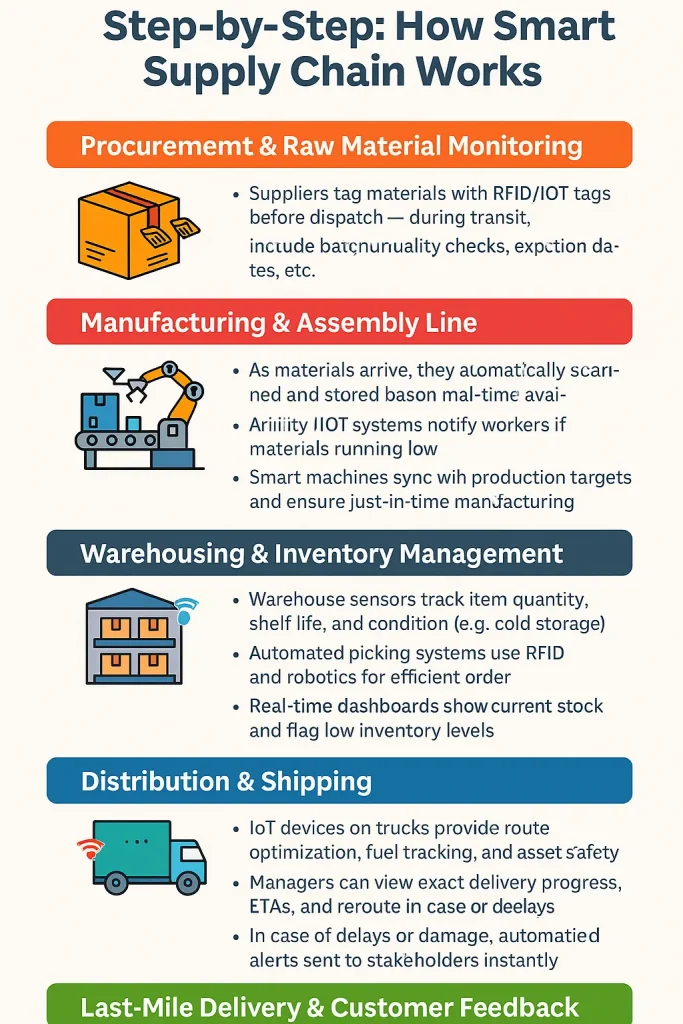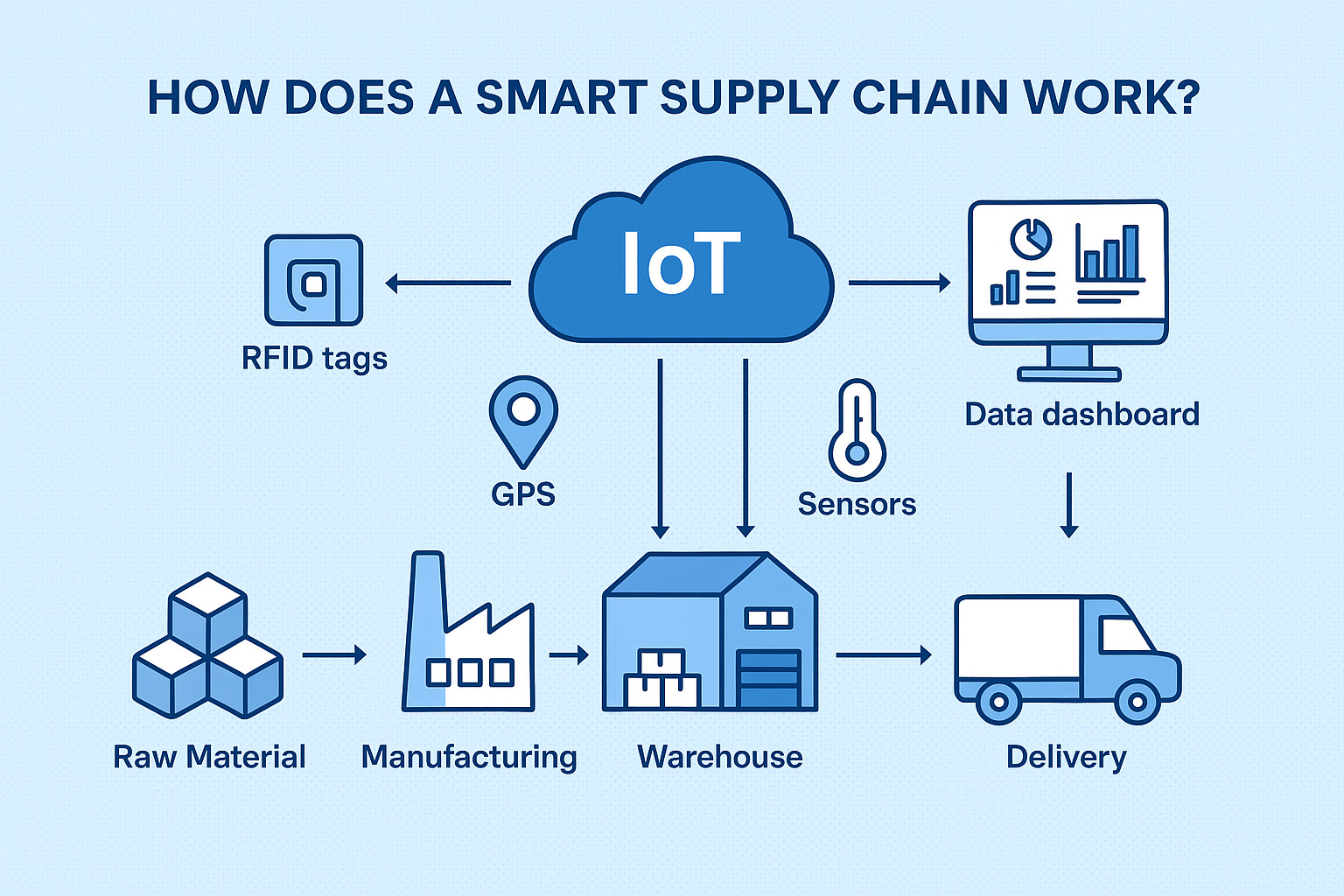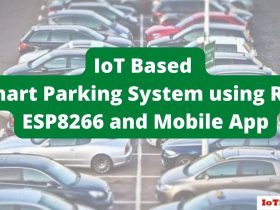How Smart Supply Chain Works | Full Breakdown for Beginners
Introduction: From Traditional to Smart Supply Chains
Supply chains have come a long way. From manual record-keeping and delayed deliveries to real-time tracking and predictive automation, businesses now operate in a hyperconnected digital environment. This transformation is driven by smart supply chains, a concept made possible by technologies like the Internet of Things (IoT), RFID (Radio Frequency Identification), Industrial Internet of Things (IIoT), and AI-powered data analytics.
But how exactly does a smart supply chain work?
Let’s unpack it step-by-step, exploring the components, technologies, workflows, and real-world use cases.
Core Technologies Powering Smart Supply Chains
A smart supply chain integrates digital tools and sensors into every part of the supply network—starting from raw materials to the end consumer. These tools communicate and share data over the internet to support faster, smarter decisions.
1. RFID (Radio Frequency Identification)
RFID is one of the foundational technologies in supply chain digitization. It helps in automatically identifying and tracking tags attached to objects.
a. RFID Readers
- These devices emit radio signals and receive signals from nearby RFID tags.
- Capable of scanning hundreds of items per second, even without direct line-of-sight.
- Convert radio signals into digital data and transmit this data to backend systems (often via cloud platforms).
b. RFID Tags
- Small electronic chips with unique identification codes.
- Store data about the product: origin, batch number, expiry date, and more.
- Passive tags: No internal power source; activated by the RFID reader’s signal.
- Active tags: Battery-powered with longer range and more data storage.
- Attached to raw materials, pallets, packages, and even retail items.
c. RFID Antennas
- Work as intermediaries that transmit energy from the reader to the tag.
- Capture the return signal and direct it back to the reader for processing.
- Crucial for enabling wireless data communication between physical items and digital systems.
2. IIoT (Industrial Internet of Things)
IIoT refers to the use of IoT devices specifically in industrial environments like factories, warehouses, logistics hubs, and shipping ports.
Key Features of IIoT in Smart Supply Chains:
Real-Time Inventory Monitoring
- IIoT sensors track the location, temperature, humidity, pressure, and even shock exposure of goods.
- Warehouse managers get live updates on what’s in stock, what’s in transit, and what needs replenishment.
Predictive Maintenance
- Sensors detect early signs of machine wear, breakdown risks, or performance issues in equipment like forklifts, conveyor belts, and transport vehicles.
- Prevents delays due to unplanned equipment failure.
Automated Reordering & Demand Forecasting
- IIoT platforms analyze consumption patterns and predict future inventory needs.
- Automatically generate purchase orders before stock runs out.
- Uses AI/ML to adjust for seasonal demand, delivery delays, and market fluctuations.
Inbound & Outbound Logistics Planning
- Receive live updates about incoming shipments, helping teams allocate resources like docks, labor, and storage efficiently.
- Enhances last-mile delivery accuracy with geo-location tracking and dynamic routing.
System Integration Across Enterprise Platforms
IIoT can seamlessly integrate with:
- ERP (Enterprise Resource Planning) – manages resources, orders, and finance.
- MES (Manufacturing Execution System) – tracks production operations.
- WMS (Warehouse Management System) – manages inventory and storage.
- DCS (Distributed Control System) – monitors and controls distributed assets.
- PIMS (Plant Information Management System) – records real-time plant data.
Step-by-Step: How Smart Supply Chain Works (Explained with Examples)
Smart supply chains use IoT, automation, and real-time data to improve every stage — from raw material sourcing to last-mile delivery. Let’s walk through the journey:

1. Procurement & Raw Material Monitoring
What Happens:
Suppliers attach IoT-based RFID tags to raw materials before dispatch. These tags contain essential data like:
- Batch number
- Manufacturing date
- Expiry date
- Temperature sensitivity
- Quality certifications
During Transport:
- GPS trackers show exact location of the shipment.
- Temperature sensors ensure perishable goods (like vaccines or dairy) remain within a safe range.
Example:
A pharmaceutical company shipping vaccines from Pune to Delhi uses RFID tags and thermal sensors. If the temperature crosses the threshold, the system sends an instant alert to the logistics team.
2. Manufacturing & Assembly Line
What Happens:
- When the materials arrive, IoT scanners automatically identify them and direct them to storage or production units.
- The IIoT (Industrial IoT) setup continuously monitors machine performance, material consumption, and production pace.
Alerts:
If raw material is about to run out, the system notifies inventory managers automatically.
Example:
An automobile plant producing electric bikes gets real-time updates from assembly robots. If battery parts are running low, a system alert is triggered to restock — preventing line downtime.
3. Warehousing & Inventory Management
What Happens:
- Sensors track how many units of each item are stored.
- Cold storage sensors monitor environmental conditions.
- Robots with RFID scanners help automated picking and packing.
Real-Time Dashboards:
Show stock levels and raise warnings for expired or low inventory.
Example:
Amazon’s smart warehouses use Kiva robots that read QR codes on the floor and fetch inventory shelves to human workers or packing stations — reducing errors and speeding up delivery.
4. Distribution & Shipping
What Happens:
- Trucks are equipped with IoT telematics (GPS, fuel sensors, vehicle diagnostics).
- Managers can monitor deliveries on live dashboards.
- In case of a route delay (e.g., accident), alternate routes are automatically suggested.
Alerts:
If goods are damaged or delayed, the system notifies logistics teams and customers.
Example:
Flipkart uses IoT-based fleet management software to track deliveries. If a package is delayed due to rain in Bengaluru, it reroutes the driver via a faster road and sends customers a revised ETA.
5. Last-Mile Delivery & Customer Feedback
What Happens:
- Smart lockers or mobile apps notify customers when deliveries arrive.
- Proof-of-delivery is collected using GPS tags or digital signatures.
- Feedback collected via app is analyzed for improving future deliveries.
Example:
Swiggy’s grocery delivery app notifies you when your delivery person is 3 minutes away. After delivery, you’re prompted to rate the experience — this data helps Swiggy rate its delivery partners and optimize delivery time.
Summary Table: Smart Supply Chain Stages
| Stage | Technology Used | Real-Life Example |
|---|---|---|
| Procurement | RFID, GPS, Temp Sensors | Vaccine shipping with cold-chain monitoring |
| Manufacturing | IIoT, Real-Time Alerts | Auto plant restocking battery parts |
| Warehousing | Robots, Cold Storage Sensors | Amazon’s robotic warehouse |
| Distribution | GPS, Fuel Sensors, ETA Systems | Flipkart rerouting delayed deliveries |
| Last-Mile Delivery | Smart Lockers, Feedback Systems | Swiggy app with delivery tracking & feedback |
Use Cases of Smart Supply Chains in Different Industries
| Industry | Application |
|---|---|
| Retail | Live inventory across stores and warehouses |
| Pharmaceutical | Temperature-controlled drug delivery |
| Food & Beverage | Cold chain tracking for perishable goods |
| Automotive | Real-time monitoring of spare parts and assemblies |
| Logistics | Fleet optimization and dynamic route management |
Benefits of a Smart Supply Chain in 2025
- Data-Driven Decision-Making
- Improved Forecasting & Demand Planning
- Faster Delivery Cycles
- Reduced Operational Costs
- Increased Transparency & Product Authenticity
- Eco-Friendly and Sustainable Operations
- Lower Equipment Downtime
- Stronger Supplier Relationships
Future Trends in Smart Supply Chain Technology
Looking ahead, smart supply chains will become even more powerful with:
- AI-powered supply orchestration
- Blockchain for secure, tamper-proof transactions
- Digital twins to simulate supply chain models
- Edge computing for ultra-fast decision-making
- 5G connectivity enabling massive IoT device networks
Conclusion
The working of a smart supply chain is all about combining real-world operations with digital intelligence. Technologies like RFID, IIoT, and data analytics are reshaping how businesses operate—offering speed, accuracy, sustainability, and transparency.
For students, tech enthusiasts, and future professionals, understanding this ecosystem is not just important—it’s essential for the future of work.
See also: What is Smart building? Understanding its Working and Benefits
Ready to Explore More? Let’s Build Smarter Together!
🔔 Subscribe to Our YouTube Channel » for IoT video Tutorials.
🌐 Start Learning IoT Basics Now » and What is IoT? – Introduction to IoT and IoT Architecture: 4 Essential IoT Layers Simplified for Beginners on IoTDunia.com! and Check out Top IoT Applications in Real World – Smart Use Cases 2025, IoT career guide 2025, Best Projects on IoT for Beginners
👉 Have questions? Drop them in the comments!
💡 Start small, stay curious, and make your world smarter—one device at a time.










Leave a Review